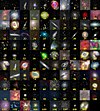NGC 3132
| Planetarischer Nebel NGC 3132 | |
|---|---|
 | |
| Aufnahme des James-Webb-Weltraumteleskops | |
| AladinLite | |
| Sternbild | Segel des Schiffs |
| Position Äquinoktium: J2000.0 | |
| Rektaszension | 10h 07m 01,7s [1] |
| Deklination | −40° 26′ 12″[1] |
| Erscheinungsbild | |
| Scheinbare Helligkeit (visuell) | 9,2 mag [2] |
| Scheinbare Helligkeit (B-Band) | 8,2 mag [2] |
| Winkelausdehnung | 1,47′ × 1,47′ [1] |
| Zentralstern | |
| Bezeichnung | Gaia DR3 5420219732228461184 [3] |
| Scheinbare Helligkeit | 16,1 mag [4] |
| Physikalische Daten | |
| Rotverschiebung | (163 ± 120) · 10−6 [1] |
| Radialgeschwindigkeit | (+49 ± 36) km/s [1] |
| Entfernung | 6376 ± 2816 Lj [5] |
| Geschichte | |
| Entdeckung | John Herschel |
| Datum der Entdeckung | 2. März 1835 |
| Katalogbezeichnungen | |
| NGC 3132 • PK 272+12.1 • ESO 316-PN27 • GC 2017 • h 3228 • Hen 2-40 • AM 1004-401 • Sa 2-53 • CS=10.1 | |
NGC 3132 ist ein Planetarischer Nebel im Sternbild Segel des Schiffs am Südsternhimmel. Er ist etwa 6.500 Lichtjahre von der Sonne entfernt und expandiert mit einer Geschwindigkeit von rund 15 Kilometern pro Sekunde. NGC 3132 hat eine Flächenausdehnung von 1,47' und eine scheinbare Helligkeit von 9,2 mag. In manchen Publikationen[5] wird er aufgrund seiner Ähnlichkeit zu M57 auch als Südlicher Ringnebel bezeichnet.
Der planetarische Nebel NGC 3132 wurde am 2. März 1835 von dem britischen Astronomen John Herschel entdeckt.[6]
- Aufnahme des Hubble-Weltraumteleskops
- (c) NASA, ESA, CSA, STScI, and the Webb ERO Production Team, CC BY 4.0Aufnahme im mittleren Infrarot mithilfe des James-Webb-Weltraumteleskops
Literatur
- König, Michael & Binnewies, Stefan (2023): Bildatlas der Sternhaufen & Nebel, Stuttgart: Kosmos, S. 226
Weblinks
Einzelnachweise
Auf dieser Seite verwendete Medien
Autor/Urheber: Roberto Mura, Lizenz: CC BY-SA 3.0
Caldwell Catalogue objects.
(c) NASA, ESA, CSA, STScI, and the Webb ERO Production Team, CC BY 4.0
The NASA/ESA/CSA James Webb Telescope has revealed the cloak of dust around the second star, shown at left in red, at the centre of the Southern Ring Nebula for the first time. It is a hot, dense white dwarf star.As it transformed into a white dwarf, the star periodically ejected mass — the shells of material you see here. As if on repeat, it contracted, heated up, and then, unable to push out more material, pulsated.At this stage, it should have shed its last layers. So why is the red star still cloaked in dust? Was material transferred from its companion? Researchers will begin to pursue answers soon.The bluer star at right in this image has also shaped the scene. It helps stir up the ejected material. The disc around the stars is also wobbling, shooting out spirals of gas and dust over long periods of time. This scene is like witnessing a rotating sprinkler that’s finished shooting out material in all directions over thousands of years.Webb captured this scene in mid-infrared light — most of which can only be observed from space. Mid-infrared light helps researchers detect objects enshrouded in dust, like the red star.This Mid-Infrared Instrument (MIRI) image also offers an incredible amount of detail, including a cache of distant galaxies in the background. Most of the multi-coloured points of light are galaxies, not stars. Tiny triangles mark the circular edges of stars, including a blue one within the nebula’s red bottom-most edges, while galaxies look like misshapen circles, straight lines, and spirals.MIRI was contributed by ESA and NASA, and the instrument was designed and built by a consortium of nationally funded European Institutes (The MIRI European Consortium) in partnership with JPL and the University of Arizona.For a full array of Webb’s first images and spectra, including downloadable files, please visit: https://esawebb.org/initiatives/webbs-first-images/
NGC 3132 is a striking example of a planetary nebula. This expanding cloud of gas, surrounding a dying star, is known to amateur astronomers in the southern hemisphere as the Eight-Burst or the Southern Ring nebula.
Zwei Kameras an Bord des James-Webb-Weltraumteleskops nahmen das neueste Bild dieses planetarischen Nebels auf, der als NGC 3132 katalogisiert und informell als Südlicher Ringnebel bekannt ist. Er ist etwa 2.500 Lichtjahre entfernt.






